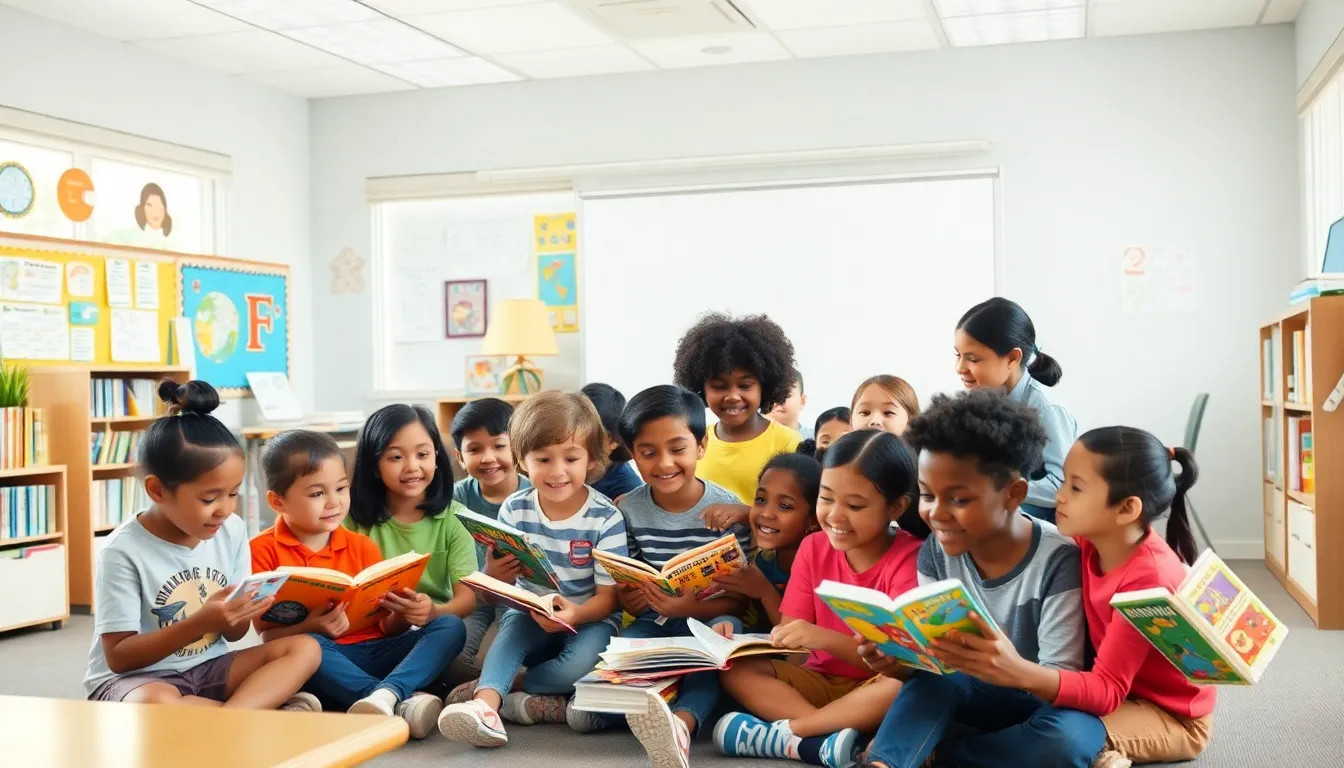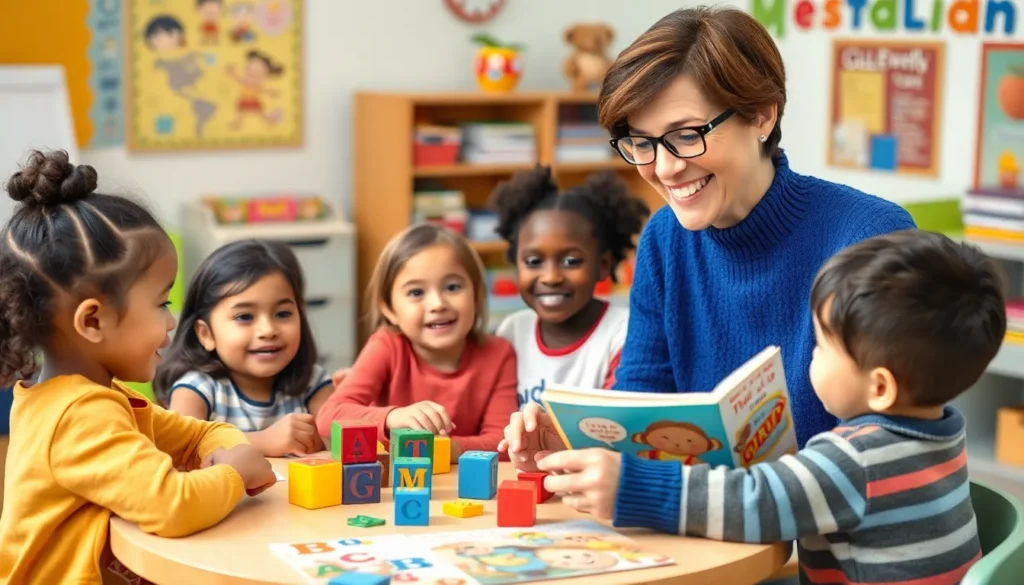Table of Contents
ToggleLiteracy is like a rollercoaster ride—thrilling, sometimes a bit scary, but ultimately rewarding. Understanding the stages of literacy development can make the journey smoother for both kids and their caregivers. With the right chart in hand, navigating through the twists and turns of reading and writing becomes a breeze.
Understanding Literacy Development
Understanding literacy development involves recognizing distinct phases that children experience as they learn to read and write. Early exposure to reading helps build a strong foundation. Children often explore letters and sounds, progressing from basic recognition to more complex comprehension skills.
Phonemic awareness plays a critical role at the initial stage. Children begin to identify and manipulate sounds, leading to improved decoding abilities. This skill fosters excitement for letters and stories.
As literacy development continues, children engage in guided reading sessions. During these sessions, they practice new vocabulary and gain fluency while developing comprehension strategies. Educators can use tailored approaches to meet individual needs.
Middle stages of literacy development reflect increased independence. They start making choices about reading materials, fostering a sense of ownership. Students might explore various genres, deepening their understanding of different contexts and themes.
In advanced stages, critical thinking becomes essential. Learners analyze texts, identify main ideas, and make inferences. They express their thoughts clearly through writing, utilizing grammatical conventions and expanding their vocabulary.
Utilizing a literacy development chart can clarify this progression. Educators and parents gain insight into the expected milestones. Regular assessment can help track children’s progress and address any challenges they may encounter. Emphasizing the relevance of these stages ensures children receive the support necessary to thrive in their literacy journey.
Overview of Stages of Literacy Development

The journey through literacy development comprises several distinct stages. Each stage builds upon the previous one, fostering essential skills for effective reading and writing.
Emergent Literacy Stage
Emergent literacy forms the foundational stage of literacy development. It begins with children’s exposure to language, sounds, and letters. Recognizing letters and understanding their corresponding sounds constitutes a key aspect. Engaging in activities such as reading aloud lays the groundwork for phonemic awareness. This interaction sparks interest in books and storytelling, making literacy an enjoyable experience.
Early Literacy Stage
The early literacy stage marks a significant shift in children’s abilities. Learners begin to recognize sight words and improve their vocabulary. Guided practice in reading familiar texts helps enhance fluency and comprehension. Children develop a better understanding of story structure and context through repeated exposure to various genres. At this stage, they become more confident in sharing their thoughts about the texts they encounter.
Transitional Literacy Stage
During the transitional literacy stage, children gain independence in reading. They explore diverse genres, allowing for a richer vocabulary and comprehension. Readers start to analyze characters, settings, and stories in greater detail. This exploration encourages critical thinking and the ability to make connections between texts and personal experiences. Diversity in reading materials supports their growth and fosters a love for literature.
Fluent Literacy Stage
The fluent literacy stage represents maturity in reading and writing skills. Children refine their abilities to analyze complex texts and express ideas effectively in writing. Critical thinking becomes vital as they evaluate themes, arguments, and perspectives. This stage also focuses on integrating reading strategies across content areas, enhancing their overall academic performance. Through practice and exploration, learners become proficient, confident readers and writers.
Importance of a Stages of Literacy Development Chart
A stages of literacy development chart provides essential insights into children’s learning paths. It outlines distinct phases in literacy acquisition, facilitating deeper understanding for parents and educators. Recognizing these stages allows caregivers to implement targeted support strategies at the appropriate times.
Tracking progress becomes simpler with a clear visual representation of literacy stages. Monitoring developmental milestones ensures that children receive timely interventions in areas where they may struggle. For instance, recognizing delays in the emergent or early literacy stages can prompt early support measures.
Understanding each specific stage helps in tailoring reading activities to meet individual needs. Educators can enhance instruction by identifying where students excel or require additional guidance. As children transition from one stage to another, they benefit from specialized techniques, such as guided reading sessions that promote vocabulary acquisition and comprehension.
Accountability increases with the use of a literacy development chart. This tool provides data that helps educators establish benchmarks for reading fluency and comprehension skills. Such metrics assist in creating personalized learning plans that cater to the strengths and weaknesses of each learner.
Collaboration between parents and teachers also improves when using a stages of literacy development chart. Clear communication fosters partnerships focused on children’s literacy growth. Parents can engage meaningfully in their child’s learning process by understanding expectations and progress.
Utilizing a stages of literacy development chart ultimately lays the groundwork for lifelong literacy skills. Facilitating a positive and supportive environment enhances children’s motivation to read and write. Engaging with texts in a meaningful way becomes the norm, promoting a love for literacy that lasts beyond the classroom.
How to Use the Chart Effectively
Understanding how to use the literacy development chart enhances its utility. Begin by identifying the current stage of a child’s literacy journey. Use observations from reading sessions to assess skills like phonemic awareness and comprehension. Tracking progress provides insights into strengths and areas needing support.
Next, set specific goals based on the chart’s milestones. Focus on particular skills, such as vocabulary expansion or comprehension strategies. These targeted goals facilitate meaningful conversations between educators and caregivers about a child’s progress.
Utilize the chart to guide instructional strategies. Educators can select activities aligned with each literacy stage, ensuring relevance to the child’s needs. Incorporating varied genres keeps reading sessions engaging and enriches vocabulary.
In addition, consistency in monitoring progress through the chart aids in identifying challenges early. When signs of struggle appear, intervention becomes timely and more effective. This proactive approach supports academic growth while fostering a love for reading.
Discuss findings regularly with caregivers to maintain alignment in supporting literacy development. Sharing insights encourages collaboration, allowing parents to reinforce learning at home. Building this partnership strengthens a child’s literacy foundation.
Finally, celebrate achievements, no matter how small. Recognition of milestones builds confidence and motivation. Using the literacy development chart empowers both educators and caregivers to cultivate lifelong literacy skills, ensuring that children experience the joy of reading and writing.
Understanding the stages of literacy development is crucial for fostering a love of reading and writing in children. By utilizing a literacy development chart, caregivers and educators can better navigate each phase and support children’s growth effectively. This structured approach not only helps track progress but also identifies areas needing attention.
Celebrating milestones encourages motivation and builds confidence in young learners. With the right strategies in place, children can thrive in their literacy journey, developing essential skills that extend well beyond the classroom. Ultimately, a collaborative effort among parents and educators ensures that every child can enjoy the lifelong benefits of literacy.







